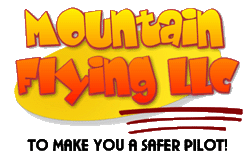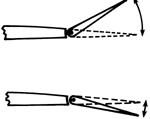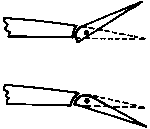Adverse Yaw
Adverse Yaw ... an operating defect
A fundamental knowledge of aerodynamics is basic to becoming a masterful pilot. A masterful pilot is a safe pilot.
Adverse yaw, like density altitude, is a term tossed about by pilots. Pilots have been trained to know what it is ... at least during their primary training. These terms often become forgotten or ignored with the passage of time.
Flight controls–to be effective–are balanced and responsive. The ailerons, however, have an operating defect.
For an airplane to turn, it must be banked so the total lift is divided into a vertical component that supports the weight of the airplane, and a horizontal component that causes the turn.
To make a left turn, the aileron control is moved left. The right aileron moves down, increasing the camber and lift of the right wing, thus causing it to rise. The left aileron moves up, decreasing the camber and lift of the left wing.
The adverse yaw problem arises (no pun intended) because lift and drag are directly proportional. With the increased lift of the right wing comes increased drag, and the decreased left on the left wing causes a decrease in drag.
These combine to cause the nose to yaw to the right. This momentary yaw (to the right in a left turn, to the left in a right turn) is adverse yaw, sometimes called adverse aileron drag.
MINIMIZING ADVERSE YAW
Some aircraft designers have tried to compensate for adverse yaw by installing either differential-type or Frise-type ailerons.
Differential Ailerons |
Frise Ailerons |
When the aileron control of differential-type ailerons is moved, the up aileron travels farther (creating more drag) than the down aileron.
When the aileron control of Frise-type ailerons is moved, an offset hinge causes the forward part of the upward deflected aileron to be exposed below the wing (creating extra drag).
Both systems eliminate much, but not all, of the adverse yaw.
TRAINING MANEUVER
(This is sometimes improperly called a "Dutch roll")
A training maneuver, called the training roll or coordination roll, is often introduced early during primary flight training to teach the pilot to cope with adverse yaw. It is mostly forgotten after the private certificate is obtained. Many instructors consider the training roll maneuver to be of greater importance in teaching someone to fly than chandelles, lazy eights, or other commercial pilot maneuvers. A pilot getting into a different airplane can determine the amount of rudder that is required for proper coordination with the ailerons by using this maneuver.
Although the training roll is a simple maneuver, it is very effective in learning how to become a real pilot. Before trying the training roll, see what happens under the following conditions.
From straight-and-level flight at cruise airspeed, try left and right turns, using only the ailerons. Watch the nose yaw opposite the desired turn.
Next, use exaggerated rudder (use too much rudder pressure) while turning and watch the nose yaw too far in the direction of the desired turn.
TRAINING ROLLS
Now, for the the training roll maneuver. Pick a prominent point on the horizon and roll into a bank in either direction. Apply coordinated rudder to compensate for adverse yaw.
If the nose yaws in the direction of the turn, too much rudder was used. If the nose yaws opposite the turn, not enough rudder was used. If the nose pivots on the reference point, the turn was coordinated.
When the desired bank is reached, use 20 or 30 degrees of bank, roll the opposite way to a bank of the same degree.
If the initial bank is to the left, it is necessary to lead the roll to the right with rudder to maintain the nose on the reference point. Again, if the nose yaws opposite the turn, not enough rudder was used. If it yaws toward the direction of the bank, too much rudder was used. If the nose pivots on the horizon reference point, you've got it. Ignore the ball of the turn-and-slip indicator during this maneuver.
During the transition from one bank to the other, the ball will be outside the index in a direction opposite the turn.
When you think you have this down, slow the roll rate, and try it again. After practicing until you can do this maneuver with precision, you are approaching a level of competency that makes you a pilot, but not a real pilot ... yet.
Next, while climbing at the best rate-of-climb speed, do the same maneuver. Besides compensating for adverse yaw, you now have to deal with torque, p-factor, asymmetrical thrust and the corkscrewing effect of the propeller slipstream.
Try the maneuver also when descending with reduced power at glide or approach airspeed.
This maneuver is particularly valuable when transitioning to different airplanes. Even airplanes of the same make and model will not fly the same, requiring different aileron/rudder coordination. When you have this maneuver down, you still cannot consider yourself a real pilot, unless you apply it to your flying.
Whenever you initiate a turn from level flight, climbs or descents, merely perform a training roll entry into that turn. When you want to return to wings-level flight, do a training roll maneuver to roll out. The turn will be coordinated. And, now you are a real pilot.
![]()
![]()


